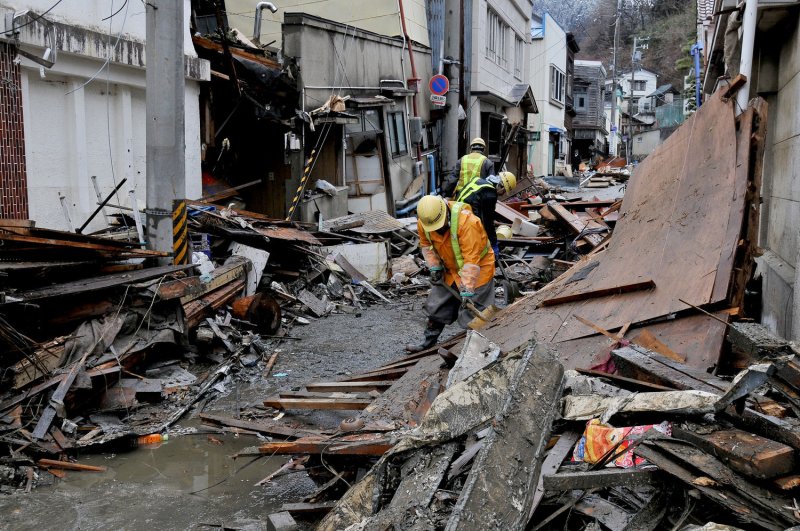1 of 10 | Workers remove rubble from destruction in Kesennuma, Miyagi prefecture, Japan, on March 16, 2011. More than 10,000 people are believed to have been killed by a massive earthquake and resulting tsunami. UPI/Keizo Mori |
License Photo
OKUMA, Japan, March 16 (UPI) -- Japanese Emperor Akihito Wednesday expressed concern for his people threatened by a nuclear crisis set off by a historic earthquake and tsunami.
The emperor made a rare televised address to the nation on a day when the quake-tsunami-crippled Fukushima nuclear plant's reactors were hit by fires and dropping water levels in pools holding spent fuel rods, which could leak massive amounts of radioactive materials if the rods start melting.
In a taped video message, the first ever by a Japanese emperor underscoring the urgency of the crises, the 77-year-old Akihito expressed concern for the quake-tsunami survivors and expressed gratitude for the rescue teams working under trying circumstances in the disaster-hit northeast regions, The New York Times reported.
Akihito said he was "deeply worried" about the ongoing nuclear crisis at various nuclear reactors brought on by last Friday's 9-magnitude earthquake that was followed by a tsunami that devastated vast sections of the northeast, killing thousands and leaving thousands more missing.
New problems developed Wednesday at Fukushima plant's No. 3 and No. 4 reactors.
White fumes, which could be radioactive steam, emanated from the No. 3 reactor, leading Chief Cabinet Secretary Yukio Edano, the government's main spokesman, to caution the containment vessel could be damaged, Kyodo News reported. There had been an explosion Tuesday at No. 3.
Tokyo Electric Power Co., the plant's operator, considered helicopter-borne boric acid spraying at the No. 4 reactor where there were threats of spent nuclear fuel rods melting. The reactor also was hit by a fire in the morning although the flames died down 30 minutes later.
Because of the rising radioactive danger, Tokyo Electric has evacuated most of its 800 workers, leaving only about 50 to handle such task as injecting seawater into the reactors to cool them.
James Walsh, a researcher at the Massachusetts Institute of Technology, told CNN the critical issue now is whether the fuel rods are melting and if so whether they can be contained.
Aftershocks numbering in the dozens also have continued to plague the region since Friday.
Experts expressed concern to the Los Angeles Times about the Friday quake setting off a shock closer to Tokyo as the aftershocks appeared to be moving south from Sendai, capital of the worst-hit Miyagi prefecture, 230 miles to the north.
A 6.2 -- magnitude aftershock was recorded Tuesday night near Shizuoka, 72 miles southwest of Tokyo, the report said. The Tokyo metropolitan area is home to more than 32 million people.
In other developments, The New York Times reported from Hong Kong officials were monitoring radiation levels and wind directions from Japan. One official said levels have so far remained normal.
The report said other nations in East Asia planned to increase inspections of food imports from Japan.
As the death toll mounted in Japan, rescue teams from 13 nations joined Japanese teams looking for survivors.
Japanese stock markets ended higher Wednesday after huge losses the previous two days. The Nikkei-225 stock index closed up 5.7 percent, and the broader Topix ended 6.6 percent higher.















